Selecting from the flight demonstration spectrumby Steve Hoeser
|
| Successful demonstration programs use technology wisely. The search for some mythical optimum is a fallacy that is to be shunned. |
First and foremost, they must separate technology demonstration programs from capability demonstrations. If the technology that needs to be employed to demonstrate a system capability is not sufficiently mature, especially in our current low-budget, quick-results mindset, one starts such efforts at your own peril. The Apollo and Cold War days of high risks and high rewards are gone, at least for now. Barring an alien battle cruiser showing up in our solar system, the driving needs to take on the inevitable risks of schedule and budget skyrocketing with technology driven new capability demonstrations is a formula for assured program failure before you start. If you set your demonstration program objects so lofty that they need advanced unproven technology to succeed, strongly consider re-evaluating your flight demonstration program goals.
Selecting the proper demonstrator program approach today starts with the fundamental understanding that because these are rapid programs they will contain risk. If not they shouldn't be called rapid demonstrations because rapid programs frazzle nerves. However, they can still succeed when they are allowed to be “run” by creative managers, architects and design engineers on both sides of the fence. They never succeed if they are “sauntered-along” by political debates, glaciated by bureaucrats, or dictated by accountants.
Successful demonstration programs use technology wisely. The search for some mythical optimum is a fallacy that is to be shunned. They forgo demanding, complex business school program oversight management systems and concentrate on producing products and useful designs that, when tested, generate the needed answers so quickly that traditional management monitoring can’t keep up. If you are time and budget constrained, better is not merely the enemy of good enough, it is its mortal enemy. My mentor, Maxwell W. Hunter, who is considered by many one of the icons of the early golden-age of high speed projects, described these kind of rapid programs this way:
“Rapid program design engineers are free to choose what they deem most appropriate for getting the job done. Outside intrusion in this loop is simply fatal. Frequently, a given team will pick a system because they are more familiar with it than another system and know how to implement it precisely with no wasted motion. If they are good, they are very alert to remaining competitive and will not let their system fall technically behind other systems for they know that will be fatal. For another design team with different background and expertise, a different solution may be optimum. There is no single solution, for design familiarity plays a major role, even when you’re not in a hurry.”2
So when selecting a vehicle demonstration program approach one should start by:
- Remembering that the point is to select a demonstration approach that takes you as far toward motivating the commitment of funding and resources to building an actual useful product and/or service capability that your available money can buy.
- Demanding a technology independent verses an unproven technology dependent design approach to keep Murphy and his gremlins at bay.
- Not getting bogged down in bureaucracy; run, don’t walk, your program.
The spectrum
Demonstration programs come in a variety of flavors. I like to call this the demonstration spectrum. Applying the guidance above I came up with five spectrum levels using the factors that influence such program efforts. Figure 1 is an attempt to visually capture the four demonstration levels that deal with flight demonstrations system.3 Each of the five demonstration spectrum levels is discussed further below.
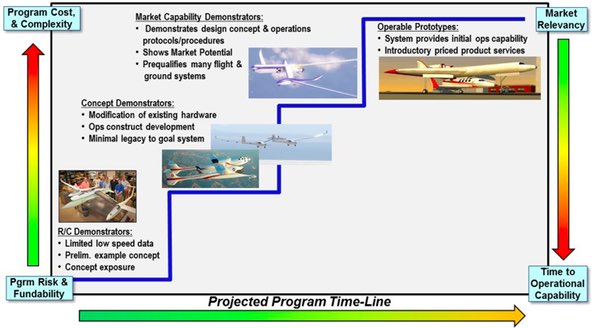 Figure 1: The demonstration spectrum for aerospace flight vehicles, illustrated using a NASA’s Towed Glider Launch System example. Note: virtual demonstrators are not shown in this illustration. |
Virtual demonstrators: At the distant low end of the spectrum are the virtual demonstrators. This is a relatively new prototyping method that has, in this author’s opinion, gained undeserved notoriety. It is used to conduct course functional design and concept tests using computer modeling or simulation environments. If the software models needed to build and test the virtual prototype exist, this can indeed be a relatively inexpensive method to increase the sales viability plus gain some insights, identify potential design issues, and build confidence on a concept. When coupled with computer-aided design models, it is indeed possible to virtually build and “fly” a flight demonstrator in the computer’s virtual world.
| But as the noted Burt Rutan has told me, “Sometimes scaling don’t!” By this he was referring to his experience that there is indeed a minimum scale that can produce useful data, |
However, as Doctors Harold and Pamela Kurstedt of Virginia Tech caution, “It must be remembered that every model is wrong.”4 The lesson is that funding organizations, their program managers, as well as the contracted developing engineers and managers, must beware the seductive lure of the modeling and simulation gods. Never forget that, though valuable as indicators, they are merely tools that approximate reality. Besides, the ultimate goal is not to create a better model of reality nor let it lure you into false comfort zones, but to create a useful and profitable real-world end product capability.
The flying part of the demonstrator spectrum: The flying part of demonstrator spectrum crosses the terrain from subscale test vehicles to threshold operable prototype demonstrators.5 This degree of flight demonstration can run all the way from radio-controlled (R/C) models to just short of a full-scale pre-operable systems; the so-call Y-Prototypes. The program leaders’ selection of flight demonstrator level must be tied closely to objectives commensurate with influencing risk, component technology, and market environment factors coupled to an understanding of achievable program scope-to-funding boundaries.
R/C Subscale Demonstrators: In many cases, the objectives of the R/C flight systems are to introduce a vehicle concept and perhaps gather some low-altitude and low speed data. Just a few examples include the Boeing Future-X vehicle, the Blended Wing Body model, the more recent Towed Glider Air-Launch system and the abandoned X-33 launcher (figure 2). Such vehicles often also have a good deal of advertising value; not necessarily a bad thing. But as the noted Burt Rutan has told me, “Sometimes scaling don’t!” By this he was referring to his experience that there is indeed a minimum scale that can produce useful data that can have direct traceability and design impacts to a future operational flight system.6
The general the rule-of-prototype-thumb seems to be that somewhere around one-quarter of full scale is the raggedy-bottom end to provide any meaningful subscale trace data. Even then, this flight data usually only resides in a rather small corner of the operating flight environment. Thus these flight results must be carefully scrutinized and then used only as gross indicators of the larger system’s behavior.
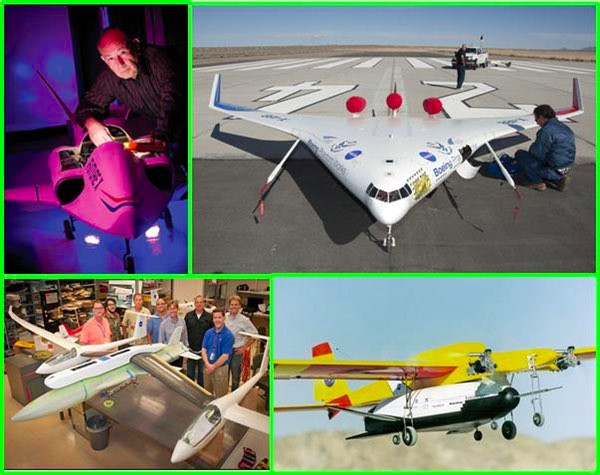 Figure 2: Example aerospace ~1/4 scale Radio Controlled (R/C) test vehicles; (upper left) Boeing Future X Aerospace Plane, (upper right) Blended Wing Body plane, (lower left) NASA Towed Glider Air-Launch system, X-33 launcher demonstrator. (Credit top right to bottom left: Boeing-Frontiers Magazine, NASA-Tony Landis, NASA-Armstrong Flight Research Center, and NASA-Dryden Flight Research Center) |
Concept demonstrators: The concept demonstrator strategy level exploits existing and proven technology and repurposed equipment by innovatively putting them together to show that a new flight concept is more than just R/C models and computer simulations. Nothing grabs the attention of investors, customers, or the public like new things flying. In executing this type of development program, invaluable general operational constructs are developed. Together these form the basis for understanding the challenges toward creating an operational flight system with sufficient performance that can operate at reasonable (read profitable) costs.
In many cases, these concept demonstrator vehicles are “one-offs.” Essentially, they are throwaway vehicles destined for destruction during testing or donation to museums after their test programs. Often call “X” or Experimental vehicles, they gather important design and flight test data. Rarely do such systems have direct legacy to the ultimate envisioned operational system. Examples of this level include the early X-planes such as the X-1 through X-24B (see this list of historical X-planes.)
A more recent example of this exploitation of existing technology at the expense of end-game performance is from the 1990s. The Delta Clipper Experimental (DC-X) was intended to demonstrate the concept that rockets could be made reusable and operated much like airplanes. This vehicle developed by the Strategic Development Initiative Office (SDIO) Technology Directorate7 was to be the first step toward building a fully reusable single stage to orbit (and return-able) space transport (see Figure 3). Though it only operated in the lower portion of a launch vehicle’s flight environment, it generated great interest and loosened up funds for a next step. At least two commercial ventures, SpaceX and Blue Origin, appear to have taken at least some of the lessons demonstrated in this program and implemented them in their current commercial rocket launch systems.
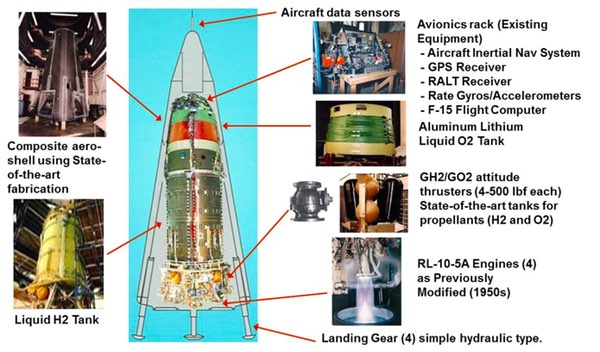 Figure 3: McDonnell Douglas chose to integrate existing technology and state-of-the-art fabrication process for their Delta-Clipper Experimental (DC-X) concept demonstrator (credit: SDIO/Technology Directorate, 1993) |
In almost all incidences, the concept demonstrator vehicle designers used existing hardware and software, or modified parts of it, to reduce cost, schedule, and risk. The downside of this approach is that the performance and technical results often will fall short of the ultimate goal flight system. This, in turn, is usually exploited by opponent spin-doctors to cast shame and doubt on viability of the flight concept.
| At least two commercial ventures, SpaceX and Blue Origin, appear to have taken at least some of the lessons demonstrated in the DC-X program and implemented them in their current commercial rocket launch systems. |
In rare cases at least portions of concept demonstration systems can have at some residual value. Such was the case of the White Knight, the X Prize suborbital space tourism demonstrator’s carrier vehicle. After winning the X Prize, White Knight was exploited in 2005 and 2006 to carry and release DARPA’s experimental X-37A spaceplane for approach and landing tests. Then, in late 2006, White Knight flew a seven-flight test program of the Adaptive Compliant Wing developed by FlexSys Inc. with funding by the Air Force Research Laboratory. In this flight series, a laminar flow test article was mounted vertically under White Knight’s centerline pylon for the 20-flight-hour research program to test the flexible wing’s aerodynamic characteristics.8,9 , White Knight was also used to briefly carry a Northrop Grumman radar pod (see Figure 4) prior to its retirement to a museum.
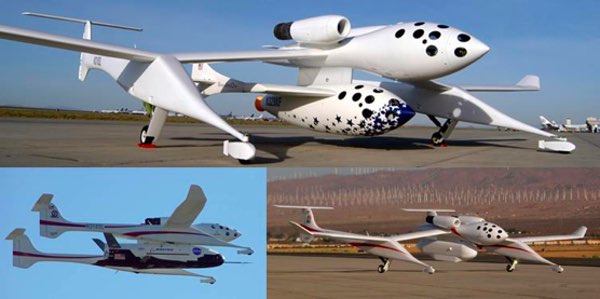 Figure 4: Scaled Composite’s White Knight One lift aircraft was used beyond the X-Prize demonstration (top) in support of X-37 drop testing (lower left) and for testing of a Northrup Grumman air-borne radar pod. (Credit: Scaled Composites & DARPA) |
Market capability flight demonstrators: Like the name implies, a market capability flight demonstrator is focused on engaging potential customers and drumming up business. The key difference is that such demonstrators have a good deal in common with the intended flight system. In both design and operating function, the flight system reflects the envisioned market product/service capability.
The full range of the system design architecture and operation protocols and procedures are a key feature of this demonstration level. What are not held firm are the final performance requirements. A launch vehicle system like the envisioned NASA Towed Glider Air-Launch System (TGALS), for example (see figure 5), may not be paired with a booster that can get a payload into orbit that meets a projected market need. However, such a flight demonstration vehicle when paired with a different booster or linked to an alternate sub-orbital mission may indeed generate sufficient customer interest to secure funding to build an operational design that is closely based on the market capability demonstrator. The key intent at this level is to show the viability and secure evidence of measurable aspects of the flight concept’s operations and capabilities.
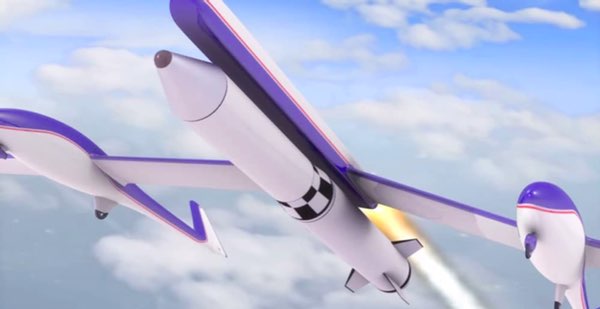 Figure 5: Artist’s Towed Glider Air Launch System (TGALS) concept in final high angle of release acceleration maneuver prior to release of a generic small space launch vehicle. (Credit: NASA Armstrong Center) |
Another cost-managing trait of the market capability demonstrator level is that the component hardware and software on market capability demonstrators may be a mixture of existing and emerging technologies. These conditions can step-up the prequalification of many of the flight and ground systems. This is accomplished because such flight demonstrator programs can often avoid the added burden of meeting the costly and extended testing needed for actual certification standards of new flight and ground system technologies and subsystems.
| Users of this general guidance need to be wary of the seductive sirens of pressing too far up the scale too soon and be especially sensitive to the current cultures and environments in which their demonstration level selections must play. |
Operable prototype demonstrators: This class of demonstrator though designated a prototype is not the Y-Prototype often associated with Full Scale Engineering Development (FSED) programs. Although it may be close or even full-scale, it does not conform to all operational requirements levied on vehicle systems that are to be placed into full commercial or military service. This is a distinctive and seductive class of flight vehicle system because it can provide an initial introductory product/service following the demonstration test program. These systems can provide the clear engineering, functional, operational, and component trace that is necessary to secure the confidence needed to obtain large-scale financial backing and customers. Depending on the selected business transition strategy these systems (or as in the case of the White Knight, parts of the system) can proceed into a limited operational service or even be sold to an interested buyer. If the very high initial investment can be secured—a big if—this flight demonstration approach affords the potential for an earlier return on investment and value generation for the sponsor company or agency.
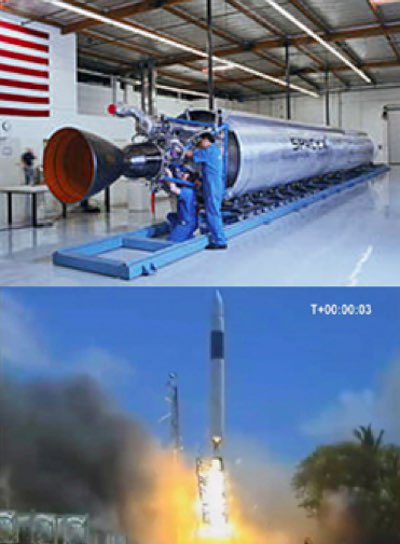 Figure 6: SpaceX Falcon 1 was a wrong bet on an operable prototype small satellite rocket. (Credit Wikipedia and SpaceX internet video) |
The cautionary downside of this all-out flight demonstration approach is that even with diligent market analysis, what a sponsoring program management predicts will be a marketable product/service system can often be a disastrously flawed assumption. Such was the case when Elon Musk bet on his small Falcon 1 booster (see Figure 6). SpaceX had been developing this booster as an operable prototype demonstrator on speculation. They had even lined up the Defense Advanced Research Projects Agency (DARPA) FalconSat-2 as the rocket’s payload. Unfortunately, after a third failed launch attempt SpaceX realized that a booster of this size had virtually no profitable and sustainable market at that time, and so it was eventually dropped. In retrospect, had this program and booster perhaps waited about 10 years to a time when the small satellite and CubeSat revolution is now in play, the business case for continuation of this product/service line might have been justified. To paraphrase an old Orson Wells Paul Masson wine commercial of the 1970s, “You shall sell no launch vehicle before its time.”
Findings
This paper has offered an overview of the spectrum of flight demonstration program approaches, some general guidance, and examples on how to not only to rekindle, but also to sustain and profit from the tailoring and execution of wisely-selected system flight demonstration programs. There are, of course, many details and hard-earned lessons that have been purposely omitted from this paper for brevity. Users of this general guidance need to be wary of the seductive sirens of pressing too far up the scale too soon and be especially sensitive to the current cultures and environments in which their demonstration level selections must play. Ultimately these efforts are about advancing capabilities to meet the needs of the end users by the introduction of new flight system capabilities.
Endnotes
- Maxwell Hunter, “The SSX: A True Spaceship”, briefing presented to Vice President Quayle by M. Hunter, J. Pournelle, Gen. D. Graham, dated 4 October, 1989.
- Maxwell W. Hunter, “Rapid Programs vs. National Programs”, White Paper, 8 November 1990.
- The author encourages shameless exploitation of this figure for your own demonstration program development purpose.
- Harold Kurstedt, Introduction lecture to Systems Thinking Certificate Courses, Virginia Polytechnic satellite course, March 28, 2002.
- Note to Reader: The term Advanced Capability Technology Demonstrator or ACTD used during the late 90s and into the early 2000s encompassed both subscale and operational prototype systems.
- Burt Rutan, A. O. Tischler, Max Hunter, Gen Ben Schriever, Gen Dan Graham and Steve Hoeser, Meeting conversations, High Frontier conference room, Arlington, VA, March 1990.
- The SDIO was renamed by President Clinton in 1993 to the Ballistic Missile Defense Organization (BMDO) part way through the DC-X program, which itself also went through several managing organization name changes.
- Scott, William B, "Morphing Wings", Aviation Week & Space Technology, 2006-11-27.
- Scott, William B, "White Knight Back in Action", Aviation Week & Space Technology, 2006-11-27
